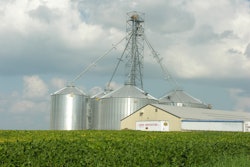2011年10月爆炸的堪萨斯粮食elevator that killed six people tragically highlights one of the most serious hazards feed and grain processing companies manage every day — combustible dust. The loss of an employee and community-member is certainly the ultimate price paid for ineffective dust control, but loss of equipment and product, as well as nonfatal injuries, can also occur.
Nearly 280 dust fires and explosions occurred in U.S. industrial facilities from 1980 to 2005, resulting in approximately 119 fatalities and over 700 injuries, according to the Chemical Safety Hazard Investigation Board (CSB).
Protecting your facility from a potentially lethal situation starts with understanding the cause of an explosion and assessing the hazards present in your processes. Then, following up with an effective dust control and explosion prevention plan is integral to ensuring a safe environment.
Explosion pentagon
We all know spontaneous combustion is more urban legend than reality, so what does it take for an explosion to occur? David Grandaw, regional sales manager for Fenwal, Ashland, MA, says “The rule of thumb is if it can burn as a solid, it can explode in dust form. All it takes is having the right factors in place.”
Often referred to as the “explosion pentagon,” the five circumstances that must come together to create a dust explosion are:
- Fuel - dust or fine particles
- Dispersion – dust suspension in air
- Oxygen
- Confinement – inside a vessel or room
- Ignition Source
Dust collection
Managing dust — an explosion’s fuel source — is one of the most important steps an employer can take toward reducing combustible dust hazards. An effectively designed dust mitigation approach combines exhaust fans, dust collectors and housekeeping.
The National Fire Protection Agency (NFPA) is a national safety standard setting organization that has developed a standard for combustible dust hazards in industrial facilities. The standard — NFPA 654 — is what OSHA relies on to inspect facilities since the agency still has not submitted its own much anticipated final ruling on combustible dust.
NFPA 654 says to minimize the release of dust companies should not employ open loading processes.
However, many loading, unloading and processing applications in a feed and grain facility cannot be done in a closed environment. Colonna says when that’s the case, the standard’s alternate option is to use a hood or exhaust system, so rather than dust releasing into the air, it’s captured and taken to either a main, central dust collector or a smaller, dedicated collector.
Kirt Boston, Industrial Air Filtration program manager for Donaldson Torit of Minneapolis, MN, says now more than ever, dust collectors are designed with safety in mind.
“As recently as 10 years ago, it was commonplace for all processes to be connected through ductwork leading to one central dust collector,” explains Boston. “The danger is if a collector explosion occurs, fire goes back into the ductwork, involving other systems that otherwise might not have had contact with the explosion.”
As a result, Boston has seen a downsizing trend in dust collectors take shape. Smaller, dedicated collectors designed specifically for installation near a piece of equipment and runs concurrently with the process can improve dust control efforts and reduce the chance of an explosion traveling throughout the facility.
Investing in higher performing dust collectors also helps reduce the housekeeping load a facility has to manage, a main provision in NFPA 654. “If you do a better job of containing dust to begin with, it isn’t in the housekeeping environment; it’s kept inside the process,” adds Boston.
Housekeeping measures
Dispersion — dust suspension in the atmosphere — the second factor in the explosion pentagon, can be controlled with various housekeeping measures. If an explosion has already begun, in a collector for example, dust accumulated on the floor and in the beams and rafters can be knocked loose and become suspended in the air to provide fuel for a secondary, and often more powerful blast.
NFPA 654’s stance on housekeeping is that a hazard is present when accumulation is anywhere from 1/8 to 1/32 of an inch, depending on the bulk density of the dust, which proper laboratory testing reveals.
One-thirty-second of an inch is about the thickness of a mechanical pencil lead or a metal office staple. The NFPA’s Guy Colonna, staff liaison, admits that 1/32 of an inch sounds miniscule, but if that amount covers the entire working surface of a facility, it could create a dust cloud with the ideal concentration to form a combustible dust explosion.
“It is a very small amount of dust, yet it represents that marginal threshold above which you can be certain there is enough dust present that if it gets thrown into the air and becomes suspended and concentrated, you have a significant and legitimate hazard,” says Colonna.
According to Colonna, a provision in NFPA 654 that will be adopted next year includes a formalized hierarchy of safe housekeeping measures:
- Vacuum dust with a properly designed vacuum that is intrinsically safe, bonded and grounded, so it doesn’t become an ignition source. It may be vented or ducted to a dust collector.
- If the vacuum cannot reach corners or tight spaces, conduct a water wash down or sweep with a broom
- Finally, cleaning with compressed air is permissible in small areas if the previous two measures are not effective in removing the dust.
Spark detection
Even with effective dust collectors and diligent housekeeping, the threat of an explosion may still be present if ignition sources are not properly dealt with.
Generally speaking, the first four factors of the explosion pentagon may co-exist without causing an explosion, but the final factor — ignition — is all the catalyst needed to set off an explosion.
Common ignition sources include sparks generated by milling processes that are grinding or abrasive, or heat from friction-causing equipment. Colonna notes that upkeep and maintenance of equipment plays an important role in minimizing ignition sources.
“In grain handling you have bucket elevators, conveyors, and other pieces of equipment that that are propelled by bearings and gears,” says Colonna. “When maintenance fails, the equipment can seize or jam up, causing either over-heating or friction, which generates sparks and can become an ignition source.”
Spark detection systems were introduced to the U.S. market in the late 1970s, according to Allen Wagoner, president of Greensboro, NC-based Flamex.
Spark detectors are high-speed infrared sensing devices usually mounted on material handling ducts where dust is pneumatically conveyed.
“If a spark is detected in the ductwork or a collector, the sensor redirects the airflow or causes suppression by water or another extinguishing agent to eliminate the ignition source,” says Wagoner.
Bob Barnum, vice president of sales for Grecon, Alfeld, Germany, notes that many agricultural companies choose diversion or chemical suppression over water suppression.
“The typical milling application ends by sending the product into a storage silo,” says Barnum. “Using a fine mist of water to extinguish the spark could cause damage to the stored grain and form mold or mycotoxins, so chemical suppression or diversion techniques are commonly used in agriculture.”
Supression, isolation and venting
In addition to managing dust and eliminating ignition sources, precautions including suppression, isolation and venting are required to ensure a safe outcome if an ignition source is generated and an explosion occurs.
With suppression, when sensitive heat or pressure sensors detect a hazard, they release a chemical, usually sodium bicarbonate, to quench the fireball and reduce the build up of pressure before an explosion can happen.
Meanwhile, explosion Isolation — a provision in NFPA 654 — requires barriers positioned throughout the processing system to prevent an explosion from traveling downstream.
Chemical suppressants may be released at one process to quell the initial blast, or can be installed throughout the ductwork to act as an isolation method.
“If you invest in a sensor and the control panels, it’s a very small incremental step to do both the suppression and isolation chemically, rather than try to do them independently through mechanical means,” says Boston.
Mechanical isolation devices, like slide gates that quickly slam shut to cut off nearby areas from harm, are permitted, but Fenwal’s Grandaw notes that mechanical isolation has some limitations.
“These gates have to shut extraordinarily fast in order to be effective, and on large ducts it generally isn’t feasible because they would be too heavy and expensive,” says Grandaw. “The mechanical solution is better suited for small ducts.”
NFPA also recognizes venting as a method for isolation. If there’s an explosion in a dust collector, sensors detect the excess pressure and open a relief valve, thus protecting the dust collector from explosion.
Flamex瓦格纳解释反向气流的作用dampers play in explosion venting.
“If there is an explosion in a dust collector or a bin, the explosion will travel in all directions to the weakest point and take the path of least resistance,” says Wagoner. “In many cases it will go up the ductwork towards the production area so the explosion backdraft dampers can be used to prevent a deflagration from going back into the duct and, venting the collector at its intentionally most vulnerable spot.”






















